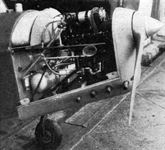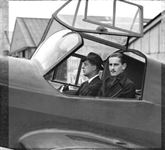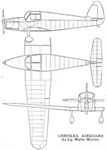
Flight, April 1938
Another Mediumweight
THE already large number of medium-light and ultra-light machines which are either in the design or the prototype stage has recently been increased by one - the product of the Chrislea Aircraft Co., Ltd., of 61, Goldney Road, London W.9.
This machine, which is in process of construction, is a side-by-side two-seater low-wing monoplane on fairly conventional lines, with simple, manually operated half-span flaps and folding wings. The undercarriage, which is of the cantilever type, is attached to the front spar of the stub wing and the shock is taken by compression rubbers. The machine is mainly of spruce and plywood construction, with welded steel for such parts as the engine mounting and undercarriage attachments. It is stressed for aerobatics and is primarily designed for club and private-owner use. The price has not yet been settled, but in the word of tire designer this will be "attractive."
The engine to be fitted is the Walter Mikron Mark II of 62 h.p., and the Chrislea Aircraft Co., Ltd., tell us that they have obtained the sole rights for the manufacture and distribution both of this engine and of the Mark I model.
The provisional specification of the Chrislea monoplane is as follows: Weight empty, 640 lb.; all-up weight, 1,125 lb., maximum speed, 118 m.p.h.; cruising speed, 110 m.p.h.; landing speed (flaps down) 36 m.p.h.; rate of climb, 650 ft./min., and range 450 miles.
Описание:
- Flight, April 1938
Another Mediumweight - Flight, September 1938
FOR the C.A.G. - Flight, October 1938
British Sport and Training types - Flight, November 1939
Britain's Civil Aircraft
Фотографии
-
Aviation Historian 8 / R.Riding - The Aeroplane that Flies Itself
Регистрационный номер: G-AFIN [14] The Airguard photographed at Heston during the first week of September 1938.
Designed to meet the specifications issued by the Civil Air Guard for a cheap and simple aircraft with which to train civilian reserve pilots, the cunningly named Chrislea LC.1 Airguard was completed in the late summer of 1938 and registered G-AFIN. Its foreign engine precluded its selection and only one was built. -
Aeroplane Monthly 1987-02 / M.Jerram - For Business and Pleasure
Регистрационный номер: G-AFIN [14] The Chrislea L.C.1 Airguard G-AFIN. Built at Heston in 1938, the side-by-side cabin two-seater was powered by a 62 h.p. Walter Mikron 2 engine. The L.C.1 had an all-up height of 1,300lb and cruised at 101 m.p.h.
Sporting its dapper undercarriage fairings, or “spats”, and its final dashing pale blue and white colour scheme, the sole Airguard awaits another flight from Heston. It appears that the aircraft was never evaluated by the Air Ministry for Civil Air Guard service, possibly owing to its foreign engine, but also perhaps because of the perception that its neutral stability may have limited its value as a military trainer. -
Aeroplane Monthly 1988-08 / R.Riding - Chrislea Airguard /British prewar lightplanes/ (2)
Регистрационный номер: G-AFIN [14] The Airguard in its revised paint scheme at Heston in November 1938. Note the fully-faired undercarriage legs and wheel spats.
-
Flight 1939-02 / Flight
Регистрационный номер: G-AFIN [14] The Chrislea monoplane in its finished and spatted form. This two-seater lightweight has a maximum speed of 118 m.p.h., a cruising speed of 105 m.p.h. and a range of 350 miles. The permissible disposable load of the Chrislea, which has a Walter Mikron engine, is 488 lb.
-
Aeroplane Monthly 1987-01 / G.Cains - Fast and furious (1)
Регистрационный номер: G-AFIN [14] OUT AND ABOUT: The Chrislea monoplane has now done quite a lot of test flying in the hands of Mr. Dawson Paul and appears to be well up to expectations in general performance. This machine is a side-by-side seater cabin monoplane with a Mikron engine (for which, incidentally, the Chrislea people are licensees) and every effort has been made in it to produce a machine possessing a good view and safe flying characteristics with a normally conventional layout.
The sole Chrislea Airguard, designed by Messrs R. C. Christophorides and B. V. Leak and built at Heston tn 1938. This two-seater had a cruising speed of 104 m.p.h. and an empty weight of only 640 lbs -
Flight 1938-09 / Flight
Регистрационный номер: G-AFIN [14] By means of ply-covered balsa, the fuselage is faired off to the extremity of the rudder.
-
Aeroplane Monthly 1988-08 / R.Riding - Chrislea Airguard /British prewar lightplanes/ (2)
Регистрационный номер: G-AFIN [14] The Airguard’s deep fuselage is very apparent in this view taken at Heston in 1938.
-
Aeroplane Monthly 1988-08 / R.Riding - Chrislea Airguard /British prewar lightplanes/ (2)
Регистрационный номер: G-AFIN [14] The Airguard in the air over Heston in September 1938.
-
Aviation Historian 8 / R.Riding - The Aeroplane that Flies Itself
Регистрационный номер: G-AFIN [14] The Airguard makes a low pass sans spats, which were found to clog up with mud and debris and were often removed. The undercarriage was of a simple half-fork type and employed eight rubber buffers under compression. The rebound was taken on one buffer with a split fibre bush bearing on a conical shoulder to serve as a check. Reportedly, the undercarriage legs could be replaced in less than 30min.
-
Flight 1938-09 / Flight
Регистрационный номер: G-AFIN [14] A fully braced mounting is provided for the Waiter Mikron engine. Normal crankcase stresses are avoided.
-
Aeroplane Monthly 1988-08 / R.Riding - Chrislea Airguard /British prewar lightplanes/ (2)
Регистрационный номер: G-AFIN [14] Close-up of the Airguard's Czech 62 h.p. Walter Mikron engine.
-
Aeroplane Monthly 1988-08 / R.Riding - Chrislea Airguard /British prewar lightplanes/ (2)
Регистрационный номер: G-AFIN [14] Entry into the aircraft's roomy cabin was via the hinged canopy.
-
Flight 1938-09 / Flight
Регистрационный номер: G-AFIN [14] Test pilot Frank Dawson Paul (nearest camera) and Chrislea co-founder Richard Christoforides demonstrate the roomy cabin of the Airguard at Heston in September 1938. Presumably this may have been the closest the latter got to experiencing the aircraft in its element, as he suffered from a fear of flying. Note how in the construction of the cockpit the two top fuselage longerons were carried on and “broken” to drop several inches to enhance the view from the cockpit, a primary aim of the design.
-
Aeroplane Monthly 1988-11 / Skywriters
Регистрационный номер: G-AFIN [14] Sole Chrislea Airguard G-AFIN, the subject of August’s British pre-war lightplanes, is being restored.
-
Aeroplane Monthly 1988-08 / R.Riding - Chrislea Airguard /British prewar lightplanes/ (2)
This “exploded” drawing of the Chrislea Airguard, and the accompanying key, shows the simplicity and robustness of its construction. The drawing indicates how many of the units can be quickly detached and replaced.
-
Aeroplane Monthly 1988-08 / R.Riding - Chrislea Airguard /British prewar lightplanes/ (2)
Chrislea Airguard
The layout of the Chrislea side-by-side two-seater. -
Flight 1938-09 / Flight
Chrislea Airguard (62 h.p. Walter Mikron)
- Фотографии
















